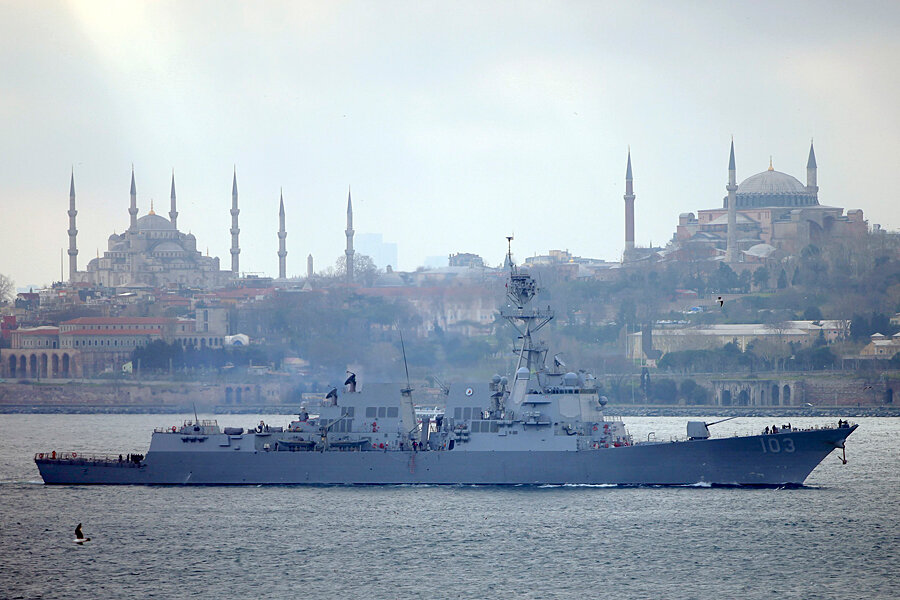Ukraine crisis: What’s the point of US military activity near Russia?
Loading...
| Washington
If stepped-up US military activity with NATO partners such as Poland and Lithuania seems like a paltry response to Russia’s military occupation of Ukraine’s Crimea province, there’s a reason for that.
The modest US show of force – a handful of jet fighters in Eastern European skies and a single warship to the Black Sea – is intended more to calm the nerves of former Soviet republics and satellites nervous about Moscow’s actions in Ukraine, regional experts say, than it is designed to send Russia into retreat with its tail between its legs.
The US military activities “are clearly meant to reassure our allies about the US commitment to NATO and to them,” says Paul Saunders, executive director of the Center for the National Interest, a Washington think tank with expertise in US-Russia relations. “It’s really an effort to demonstrate to the new NATO members in particular,” he adds, “that the US is standing with them.”
As Heather Conley of the Center for Strategic and International Studies in Washington notes, there’s even a term for what the US is looking to accomplish with its ramped up NATO-area activity. “It’s really meant as ‘strategic reassurance’ as they say in NATO parlance,” says Ms. Conley, director of CSIS’s Europe Program.
“No one wants to escalate this situation, no one sees a military solution to what’s happening in Ukraine,” she says. “But we do want to reaffirm to our Eastern European allies that NATO is going to be there for them.”
The Pentagon announced this week that it sent six F-15 fighter jets to Lithuania to beef up a NATO air patrol mission over the Baltic states, and that it was expanding joint aviation exercises with Poland. On Friday the Navy announced it has sent a guided-missile destroyer, the USS Truxtun, into the Black Sea – where Crimea is located.
The Pentagon said the deployment of the Truxtun, which is part of an aircraft carrier strike group, was scheduled before the Ukraine crisis exploded in February.
The heightened concern of the “new NATO members” – those who have joined the Atlantic Alliance since the collapse of the Soviet Union – was displayed this week when Poland requested an emergency meeting of NATO’s North Atlantic Council.
Poland cited the mutual-defense provision that figures in the Alliance’s founding charter, the same provision NATO invoked in defense of the US after the 9/11 attacks. Turkey cited the provision last year when it sought deployment of Patriot missiles along its border with Syria.
In calling for the NATO meeting, Polish diplomats said Poland felt threatened by Russia’s “aggression” in Ukraine and decided “we could not wait any longer” to seek a show of support from NATO.
“Russian military activity is not limited to blatant provocations and unlawful intervention in Crimea, or the threat of massive invasion on the territory of sovereign Ukraine,” Poland said in requesting the NATO council meeting. It went on to note that Russia had also been holding a series of military exercises near the Polish-Russian border – one, it said, with Russian President Vladimir Putin in attendance.
Secretary of State John Kerry underscored the importance of responding to the jitters running through Eastern Europe when he said at a press conference in Paris Wednesday that the Pentagon’s actions were “concrete steps to reassure our NATO allies.”
What the US military steps do not portend, everyone agrees, is a US military intervention in the Ukraine crisis.
The US spent the entire cold war avoiding a direct military confrontation with the Soviet Union, says Mr. Saunders, of the Center for the National Interest, so it’s implausible that it would engage in a military confrontation with Russia in this case, he says.
“Russia is a nuclear-weapons state, and that makes it very unlikely the US would undertake military action against it,” he says. “The Russians understand we’re not going to risk a nuclear escalation over a part of Ukraine where some 2 million people live,” he adds.
The downside of that reality is that it leaves Russia assuming that its actions are not going to get much push-back from the outside world, including the US.
“The administration has a real credibility problem with Russia,” Saunders says.
That “credibility problem” afflicting President Obama extends beyond Russia to many US allies and partners, others say. Indeed the broader message of the US military steps in Eastern Europe may be that the US is an engaged and robust power that stands by its partners, the CSIS’s Conley says.
The problem for Mr. Obama is that such steps still leave him looking like the “reactive” president who will respond to international crises as they come up but who otherwise is focused on the domestic front, she says.
“The sense out there is that foreign policy has been a distraction to this president, who wanted to focus on domestic issues,” Conley says.
“European leaders expressed concerns from Obama’s first term that there was a gap between rhetoric and actions, and then when the Arab awakening arrived there was a much broader sense that foreign and security policy was ‘intruding’ on the things that he wanted to accomplish,” she says.
Beefing up NATO activities is a credible reaction to Russia’s Ukraine gambit, Conley says. But what many people around the world “are still waiting to hear” from Obama, she adds, is not just “reaction” but the president’s foreign and security policy vision.






